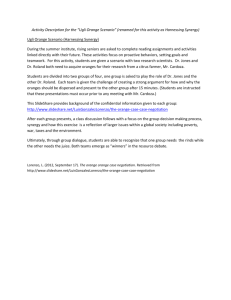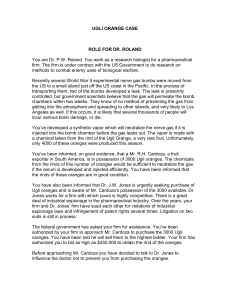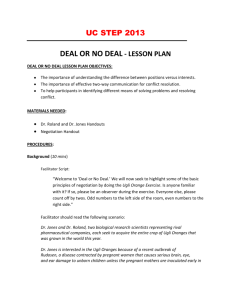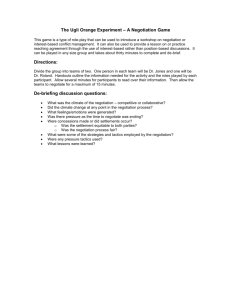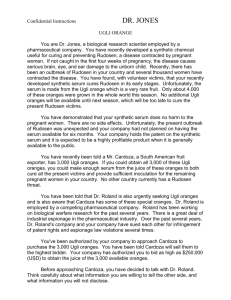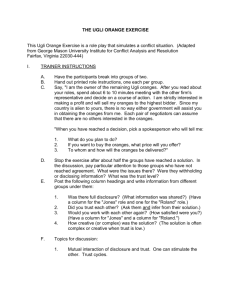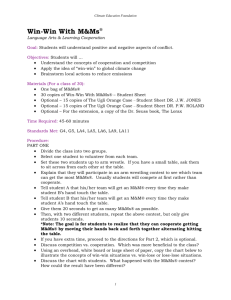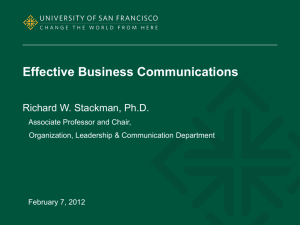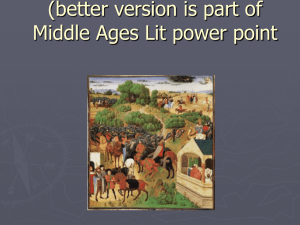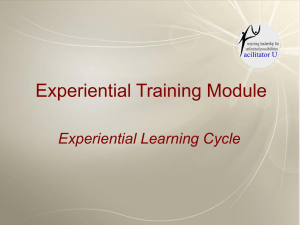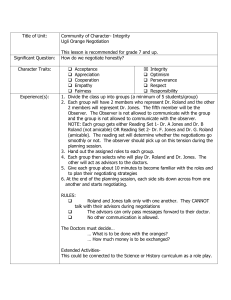Exercises - ItrainOnline
advertisement
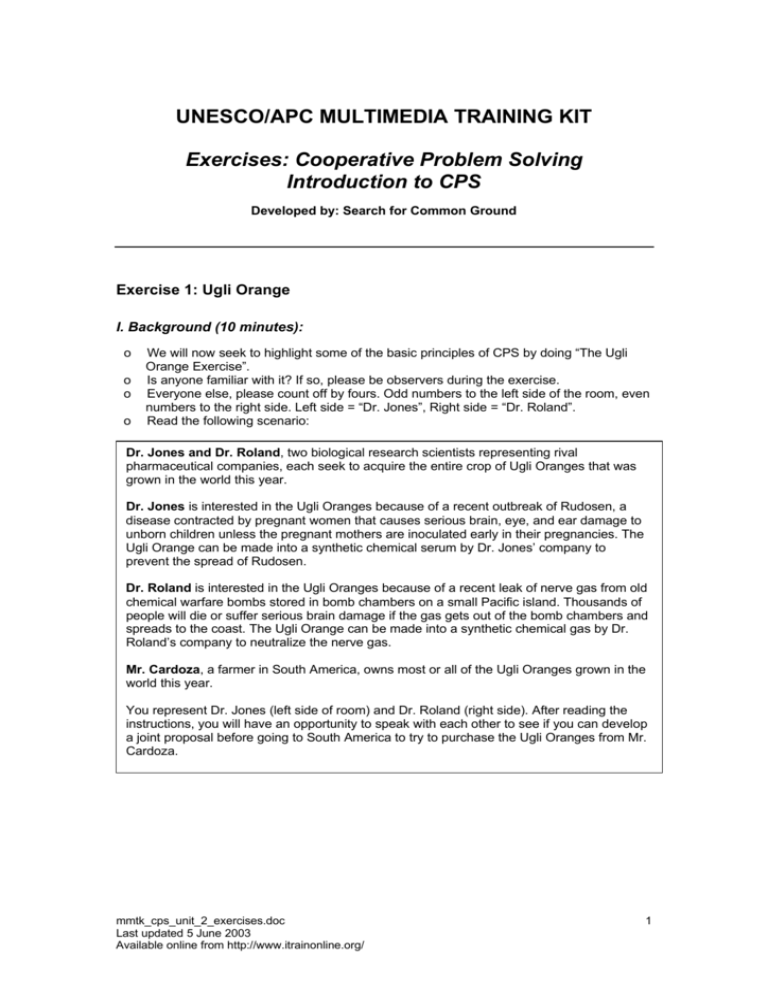
UNESCO/APC MULTIMEDIA TRAINING KIT Exercises: Cooperative Problem Solving Introduction to CPS Developed by: Search for Common Ground Exercise 1: Ugli Orange I. Background (10 minutes): o o o o We will now seek to highlight some of the basic principles of CPS by doing “The Ugli Orange Exercise”. Is anyone familiar with it? If so, please be observers during the exercise. Everyone else, please count off by fours. Odd numbers to the left side of the room, even numbers to the right side. Left side = “Dr. Jones”, Right side = “Dr. Roland”. Read the following scenario: Dr. Jones and Dr. Roland, two biological research scientists representing rival pharmaceutical companies, each seek to acquire the entire crop of Ugli Oranges that was grown in the world this year. Dr. Jones is interested in the Ugli Oranges because of a recent outbreak of Rudosen, a disease contracted by pregnant women that causes serious brain, eye, and ear damage to unborn children unless the pregnant mothers are inoculated early in their pregnancies. The Ugli Orange can be made into a synthetic chemical serum by Dr. Jones’ company to prevent the spread of Rudosen. Dr. Roland is interested in the Ugli Oranges because of a recent leak of nerve gas from old chemical warfare bombs stored in bomb chambers on a small Pacific island. Thousands of people will die or suffer serious brain damage if the gas gets out of the bomb chambers and spreads to the coast. The Ugli Orange can be made into a synthetic chemical gas by Dr. Roland’s company to neutralize the nerve gas. Mr. Cardoza, a farmer in South America, owns most or all of the Ugli Oranges grown in the world this year. You represent Dr. Jones (left side of room) and Dr. Roland (right side). After reading the instructions, you will have an opportunity to speak with each other to see if you can develop a joint proposal before going to South America to try to purchase the Ugli Oranges from Mr. Cardoza. mmtk_cps_unit_2_exercises.doc Last updated 5 June 2003 Available online from http://www.itrainonline.org/ 1 II. Confidential instructions (5 minutes): [Hand out the “confidential instructions” – “Dr. Jones” to half of the participants and “Dr. Roland” to the other half.] These confidential instructions will give you more information for your role. [Give everyone 5 minutes to read.] III. Negotiations (15 minutes): Pair up each “Dr. Jones” with each “Dr. Roland.” Ask them to find a private space for their discussion and to return in 10 minutes for debriefing. (Use breakout rooms, if any are available.) * Stop the simulation after 10 minutes. IV Debriefing Ugli Orange (15 minutes): o Did any group not come to an agreement? What were the problems? o Did any of the groups reach agreement? What were they? There will be a rich mixture of experiences for the debriefing.) Some of the pairs may not have reached a solution. The remaining negotiated solutions fall into several different categories: - Compromises in which they divide the oranges (usually 1/2 and 1/2, but sometimes 2/3 and 1/3). For pairs that discover that Dr. Roland wants only rinds and Dr. Jones wants only juice, they “expand the pie” and, in effect, get 6000 oranges. o For those who discovered the juice/rind secret: How did you find out? o Those of you who found that Dr. Roland needs the rind and Dr. Jones needs the juice, you were able to move beyond the position of “I need all of the oranges” to the interest, “I need the rinds/ juice of all of the oranges.” o Key concepts to discuss: - o The importance of understanding the difference between positions versus interests – inquiring and listening. The importance of effective two-way communication for conflict resolution. Usually, we argue for our positions and don’t talk about our interests. Often we take an adversarial approach to problem solving. Review “Problem Solving Styles” [CPS Guide, p. 4; overhead] mmtk_cps_unit_2_exercises.doc Last updated 5 June 2003 Available online from http://www.itrainonline.org/ 2 Exercise 2: Hopes and Fears I. Instructions (5 minutes): You have been having problems with someone. You want to resolve the conflict and to improve your relationship with this person, so you have decided to sit down together to try to work it out. Imagine that you will be meeting with this person in a few minutes. o o To half of the group: List on your flipchart as many answers as you can to this question: What do you hope happens? To the other half of the group: List on your flipchart as many answers as you can to this question: What do you hope does not happen? II. Groups develop their lists (10 minutes) III. Report backs (10 minutes): Typical “hopes”: [Point these out if they did not come out in the discussion] o o Good relations: I will be able to get my thoughts out clearly, keep my composure, be truthful and respectful, hold my ground. The other person will listen to me, understand my point of view, hear my frustrations. Good agreement: We will come to an understanding/agreement and solve the problem. I will get my needs met (“win”). We will have a sense of peace/respect toward each other, behave differently in the future toward each other, and have a good relationship. Typical “fears”: o o Bad relations: There will be an angry exchange; there will be a destructive confrontation or accusations, loss of tempers. I will be rejected, ignored, there will be hurt feelings, and the relationship will be jeopardized. Bad/no agreement: I won’t get what I want; the problem will be blown out of proportion or trivialized. It will make matters worse. IV. Discussion about key points (10 minutes): We all seem to want the same things: good agreements and good relationships. This is what CPS is all about – a process for developing good agreements and good relationships. mmtk_cps_unit_2_exercises.doc Last updated 5 June 2003 Available online from http://www.itrainonline.org/ 3
